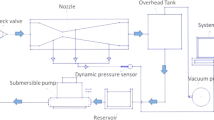Abstract
The purpose of this study is to investigate effects of length-to-width (L/W) ratio on cavitation flow inside a transparent acrylic nozzle orifice, and its effects on spray angle. Three visualization nozzles with different geometries (L/W = 2.0, 2.67, and 4.0) are used, and the working fluid is water. In order to visualize the development process of cavitation, the injection pressure of the working fluid is changed, and a high-speed camera is used with a metal-halide lamp. From experiments and analysis, some important facts are determined. As the injection pressure increases, the cavitation length and thickness increase linearly until the hydraulic flip occurs. Although the cavitation width varies according to the orifice width, the maximum cavitation thickness relative to the orifice width is almost constant at approximately 25% ∼ 30%. When the nozzle shape ratio increases, the discharge coefficient tends to increase because of the decrease in friction area. When entering the hydraulic flip region, the discharge coefficient decreases due to the reduction of the exit section area. The spray angle is affected by the cavitation number, cavitation length, cavitation thickness, and Reynolds number. The higher the injection pressure, the higher the turbulence intensity, and the greater the instability of the fluid flow.
Similar content being viewed by others
Abbreviations
- CN:
-
cavitation number
- L/W:
-
length-to-width
- P:
-
pressure
- Re:
-
reynolds number
- inj:
-
injection
References
Chaves, H. and Schuhbauer, I. (2006). Cavitation in an asymmetric transparent real-size VCO nozzle. Spray’06, Workshop uber Sprays, Erfassung von Spruhvorgangen und Techniken der Fluidzerstaubung.
He, L. and Ruiz, F. (1995). Effect of cavitation on flow and turbulence in plain orifices for high-speed atomization. Atomization Sprays5, 6, 569–584.
Lindström, M. (2009). Injector Nozzle Hole Parameters and Their Influence on Real DI Diesel Performance. Ph. D. Dissertation. KTH. Stockholm, Sweden.
Mauger, C., Méès, L., Michard, M., Azouzi, A. and Valette, S. (2012). Shadowgraph, Schlieren and interferometry in a 2D cavitating channel flow. Experiments in Fluids53, 6, 1895–1913.
Mitroglou, N., Gavaises, M. and Arcoumanis, C. (2011). Cavitation inside enlarged and real-size fully transparent injector nozzles and its effect on near nozzle spray formation. Proc. DIPSI Workshop, Bergamo, Italy.
Pang, K. M., Jangi, M., Bai, X.-S., Schramm, J. and Walther, J. H. (2017). Effects of nozzle diameter on diesel spray flames: A numerical study using an eulerian stochastic field method. Proc. 9th Int. Conf. Applied Energy, Cardiff, UK.
Park, S. H., Suh, H. K. and Lee, C. S. (2008). Effect of cavitating flow on the flow and fuel atomization characteristics of biodiesel and diesel fuels. Energy Fuels22, 1, 605–613.
Prabhakar, B. S., Laxmanrao, S. P. and Salim, K. J. A. M. (2013). Investigation of atomization and cavitation characteristics in nozzle. Int. J. Innovative Research in Science, Engineering and Technology2, 11, 6200–6206.
Pratama, R. H. and Sou, A. (2013). String cavitation in a fuel injector. Proc. 16th Annual Conf. Institute for Liquid Atomization and Spray Systems-Asia, Nagasaki, Japan.
Sou, A., Hosokawa, S. and Tomiyama, A. (2007). Effects of cavitation in a nozzle on liquid jet atomization. Int. J. Heat and Mass Transfer50, 17–18, 3575–3582.
Sou, A., Maulana, M. I., Hosokawa, S. and Tomiyama, A. (2008a). Ligament formation induced by cavitation in a cylindrical nozzle. J. Fluid Science and Technology3, 5, 633–644.
Sou, A., Maulana, M. I., Isozaki, K., Hosokawa, S. and Tomiyama, A. (2008b). Effects of nozzle geometry on cavitation in nozzles of pressure atomizers. J. Fluid Science and Technology3, 5, 622–632.
Sou, A., Minami, S., Prasetya, R., Pratama, R. H., Moon, S., Wada, Y. and Yokohata, H. (2015). X-ray visualization of cavitation in nozzles with various sizes. Proc. 13th Triennial Int. Conf. Liquid Atomization and Spray Systems, Tainan, Taiwan.
Hiroyasu, H. (2000). Spray breakup mechanism from the hole- type nozzle and its applications. Atomization and Sprays10, 3, 511–527.
Magnotti, G. M., Battistoni, M., Saha, K. and Som, S. (2018). Evaluation of a new cavitation erosion metric based on fluid-solid energy transfer in channel flow simulations. Proc. 14th Triennial Int. Conf. Liquid Atomization and Spray Systems, Chicago, Illinois, USA.
Su, T. F., Chang, C. T., Reitz, R. D., Farrell, P. V., Pierpont, A. D. and Tow, T. C. (1995). Effects of injection pressure and nozzle geometry on spray SMD and DI emissions. SAE Paper No. 952360.
Wang, F., He, Z., Liu, J. and Wang, Q. (2015). Diesel nozzle geometries on spray characteristics with a spray model coupled with nozzle cavitating flow. Int. J. Automotive Technology16, 4, 539–549.
Acknowledgement
This study was financially supported by the Basic Science Research Program (2016R1D1A3B03935537) and Basic Research Laboratory Program (2015R1A4A1041746) through the National Research Foundation of Korea (NRF) funded by the Ministry of Education of Korea.
Author information
Authors and Affiliations
Corresponding author
Additional information
Publisher’s Note
Springer Nature remains neutral with regard to jurisdictional claims in published maps and institutional affiliations.
Rights and permissions
About this article
Cite this article
Ro, S., Kim, B., Park, S. et al. Internal Cavitating Flow and External Spray Behavior Characteristics According to Length-to-Width Ratio of Transparent Nozzle Orifice. Int.J Automot. Technol. 21, 181–188 (2020). https://doi.org/10.1007/s12239-020-0018-7
Received:
Revised:
Accepted:
Published:
Issue Date:
DOI: https://doi.org/10.1007/s12239-020-0018-7



